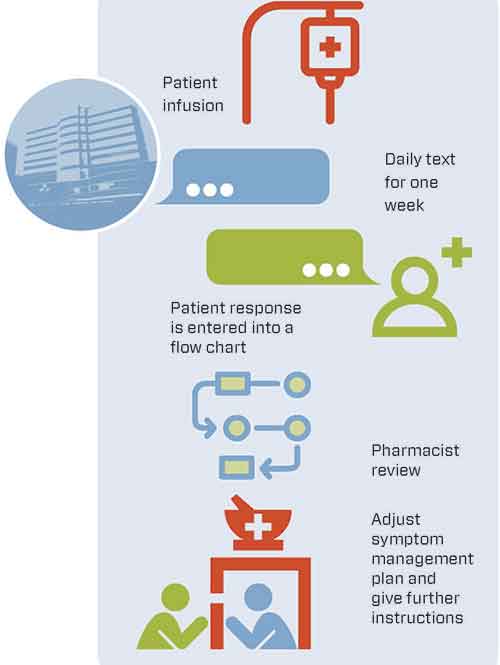New Tool Helps Patients Report Their Symptoms

Learn more about The Remote Patient Monitoring Program for Chemotherapy Related Nausea
Side effects of chemotherapy can be difficult to handle, especially nausea and vomiting. One thing that should not be difficult is communicating your symptoms to your health care team so they can help treat them.
The Remote Patient Monitoring Program for Chemotherapy Related Nausea at the University of Michigan Rogel Cancer Center helps patients receiving high emetogenic treatment deal with the difficult side effects from chemotherapy and help them feel better as soon as possible. Highly emetogenic chemotherapy means there is a 90% or higher chance a patient will experience nausea and vomiting. These side effects are serious and need treatment.
By using the new texting app to share their symptoms, patients can be more empowered to be a key part of their care team.
"We are excited about the patient self-reporting application we have developed because it will help our patients in more ways than one," says Al Quiery, M.D., medical director at the Rogel Cancer Center. "We have an opportunity to significantly improve our patients' quality of life during treatment with this program."
The program provides patients the opportunity to receive care for managing their symptoms after chemotherapy infusions. By watching patients and their symptoms closely, the cancer care team can quickly provide the best care possible.
"Some patients may notice side effects, but may not call the clinic about these symptoms," says Shannon Hough, Pharm.D. "We hope that by having information about patient symptoms earlier, even before the patient would think to call us, this can enable patients to be treated at home or in the clinic instead of these symptoms worsening, which may need urgent treatment in the emergency room or hospital."
Patients receive a daily text message for a week after their infusion that allows them to answer questions about their symptoms and their food and water intake. These responses are added to a flowchart. Responses that meet a certain threshold are sent to the cancer center clinical pharmacists to review. Pharmacists then modify the patient’s symptom management plan and instruct the patient to come to the clinic, infusion center, urgent care or emergency department, as needed.
When doctors and pharmacists work together, they can provide better care for patients. By giving patients a role in their care, the cancer center team hopes all will feel comfortable and positive with their treatment plan.
Continue reading the Fall, 2019 issue of Thrive
Learn more about chemotherapy, its side effects and ways to combat them:
Chemotherapy at Rogel Cancer Center
Symptom Management and Supportive Care Program
Chemotherapy and You [pdf courtesy of the National Cancer Institute]

